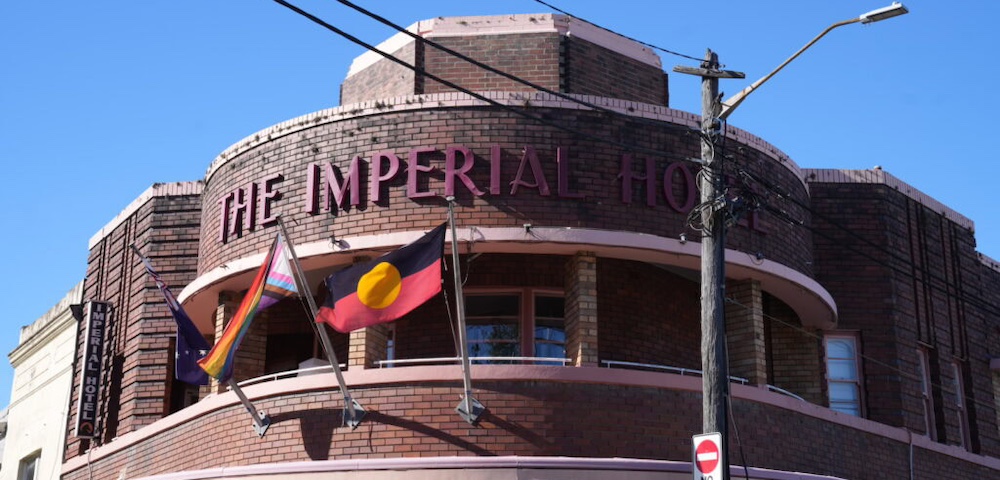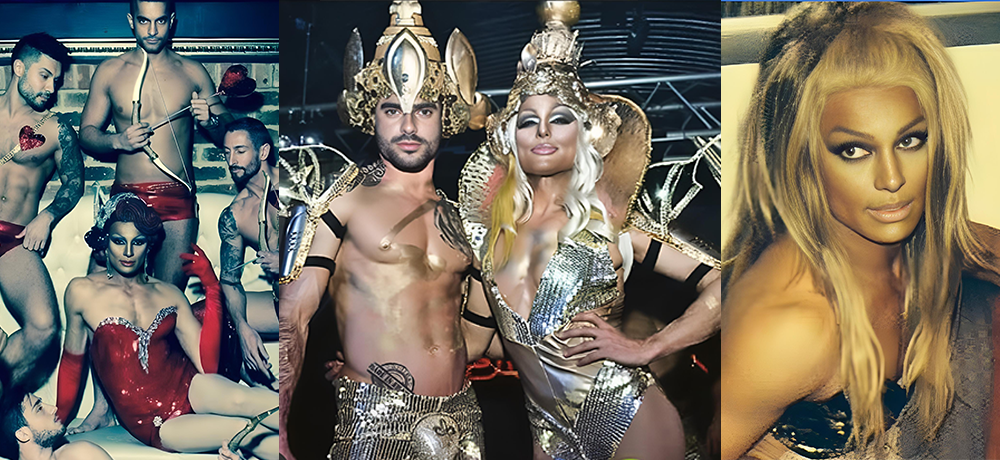
Lapses of memory
The girl’s anguished face peers into the camera. An hour earlier, Lisa Andrews* slashed her wrists in an effort to forget the abuse she suffered at the hands of Kevin O’Donnell, her local parish priest.
It’s a startling photo but Dr George Pell told 60 Minutes earlier this year that he did not remember Lisa Andrews, nor did he recall seeing this photo. But her parents, Gary and Elizabeth Andrews* still maintain they showed him the remarkable image at a private meeting in February 1997.
In a recent interview with Sydney Star Observer, Gary and Elizabeth reiterated how upset they were with the way they were treated by Pell at that meeting.
He was very unfriendly and arrogant, Elizabeth told the Star, and he was not prepared to listen to what we had to say because when we mentioned something that he didn’t want to hear, he stopped us and said something like -˜I hope you can substantiate that’ or -˜I hope you have some evidence of what you’re saying.’
And when we talked about [the amount of] compensation, he said -˜Well, if you’re not happy, take us to court.’
At one point, I mentioned something that had happened before he was Archbishop and he cut me off saying -˜That was before my time, and I’m not going to discuss that’ and that was the end of that. You have to understand that most of this history happened in large measure before he was Archbishop, said Elizabeth.
It just amazed me how disposable I felt at that meeting. It was a sense that he had all the power. And we felt that we were not important. When I went into that meeting, I took things indicating that I was a good Catholic, and that I did the baptism program; that I edited the parish magazine; and that I was a special minister of the Eucharist, and that I was not the enemy. I wanted him to know that I was an active participant in the parish community, but I didn’t even show those things to him. I know it wouldn’t have mattered. From the moment we walked in there, his whole demeanour made me feel that I meant nothing.
By the time that Pell met with the Andrews family, Fr O’Donnell had already been convicted of 12 counts of indecent assault on 10 boys and two girls. He was released in 1996 after serving part of a three year sentence and died a year later.
It is something of a surprise that O’Donnell was not brought to book earlier. He tried to drown one child; was caught in bed with another by the local parish priest; spiked the drink of another before raping her; and was caught molesting another young girl by another priest not two weeks before his trial.
Even more damning is the fact that between 1946 and 1992 when O’Donnell was allowed to retire gracefully, several members of the clergy -“ including an Archbishop and two bishops -“ were repeatedly told of O’Donnell’s molestations of young children but chose to do nothing. Instead, they preferred to offer him fulsome praise in a book produced by a church committee, presided over once again by a senior member of the Melbourne Archdiocese.
Ordained in 1942, O’Donnell was a problem almost from day one, offending in his very first parish, where he molested Joshua Mansfield*, who was then eight years old. When Mansfield finally plucked up the courage to tell John Chamberlain, the local district scoutmaster, Chamberlain was absolutely livid. Chamberlain went to see Mgr Laurie Moran, the then Vicar-General, about the matter.
I thought something would be done about it, but it wasn’t, Chamberlain told the Star. Naively, I thought that they’d talk to him, and that he’d stop it. You had such faith in those days. I had utter and complete faith.
A couple of days later, O’Donnell confronted Mans-field. He told me that he knew that it was me who had dobbed him in, and that his boss had been out to see him, and that it wasn’t going to happen again. He said it was only a problem he’d ever had with me, and that it was because he loved me. -˜I know what we’re doing is not right,’ he said, -˜but I’m only human. It’s a weakness I’ve got, but it’s only towards you.’
The abuse did not stop for the better part of another year. When Mansfield refused his advances, O’Donnell threatened to drown him. He carried me over the sandbar and into deep water. It was up around his shoulders, and I knew that I was out of my depth, Mansfield told the Star.
He began to kiss and to cuddle me, and then he started to pull my bathers down. It was then that something snapped inside me and I thought -˜Right. I’m not having any more of this,’ and I started screaming at him. I told him that I was going to tell my mother -“ though I never did -“ and that’s when he grabbed me and shoved me under the water. I really thought I was going to die.
Miraculously, the boy escaped and the abuse ended, though the impact on his life has endured through the 42 years since.
Rather than laicise him, Archbishop Daniel Mannix simply moved him on to St. Mary’s Church in Dandenong, where he soon led James Bodhill*, a 15-year-old altar boy into the presbytery and fondled his genitals. O’Donnell also abused Bodhill’s brother, his sister and his friend. The abuse almost sent his brother insane, and his sister and his friend were scarred for life.
Bishop Arthur Fox was informed of the abuse, and according to Bodhill, the Bishop drove personally to Dandenong where he reprimanded O’Donnell, a fact which Fox would deny when asked about it by a firm of lawyers in 1996.
I have not been in touch with Fr O’Donnell since 2 February 1958, Bishop Fox wrote, when I blessed the foundation stone of a new church which he was about to build in the parish of Dandenong. In all those years, and up to the present time, I have never been approached by anybody to complain about the conduct of Fr O’Donnell.
It was only in recent times, namely at the end of last year, that I heard for the first time of Fr O’Donnell’s wrongdoings when listening to a radio news report -¦ I was astounded and shocked as I had regarded him to be an excellent priest.
In spite of Bodhill’s complaint nothing was done and O’Donnell remained at the parish for the next 13 years.
In 1983 -“ by which time O’Donnell’s abuses had been well known to clergy at the highest echelons of the church for nigh on 37 years -“ the church produced a book to celebrate the centenary of the church in Dandenong: A Parish Carved From The Bush.
The book hails him as the kings of the kids, a man with a deep concern for young people. It went on to describe him as a vigorous pastor and full of vitality. Young in spirit, he had a special rapport with young people.
The book also praised his reputation as a wheeler-dealer. He was a canny buyer with a feeling for a bargain, and while some parishioners might have looked askance at his land deals, time has proved the wisdom of his moves.
The book goes on to say that when he left Dandenong for Hastings, he left behind him an outstanding record of achievement; a host of friends; and a reputation as a dedicated and understanding priest.
The book was published by the St. Mary’s Centenary Committee. Its president, Mgr Brian Walsh, who was awarded the Order of the British Empire and made a Prelate of Honour of his Holiness for his work in organising an International Eucharist Congress in the mid-1970s, oddly enough could not recall being president of the committee. Nor can he even remember the book, its title, or the fact that he wrote the preface to it.
Within months of moving to Hastings in late 1969, O’Donnell abused Damian King*, when King was recruited as an altar boy in Grade Six. The relationship started over the Christmas holidays when he invited me and a few other boys to come in and do some odd jobs around the parish like mowing the lawn, King told the Star. He convinced my parents that I should stay overnight on the Saturday so that I could go to Mass with him on Sunday morning.
I would say it was easily once a fortnight over a three year period. He was audacious in that there were so many children involved. You’ve got to realise that the police say that, statistically speaking, that if one in 12 people make a statement, it means that there are 120 victims who didn’t come forward.
I never told a soul about it, because although the sexual abuse stopped, he had an emotional hold over me, added King. He found me my first job, and he also helped pay for the school fees in the latter years of high school because my parents couldn’t afford it, and he helped me buy my first car. So, I guess I felt this sense of obligation to him. He was almost a surrogate father. So, I had this total confusion. On the one hand, sex is supposed to be a pleasurable thing, but I was in this environment where I couldn’t move, and he had this prestige as the parish priest, so he just had this power over me.
A decade later, King approached Fr Peter Slater, the parish priest at Koo-Wee-Rup, to tell him of O’Donnell’s molestation of him. I just felt that I had to talk to someone about it, and he was a young priest, so I thought he would be on my wavelength. But once I raised the issue with him, he said -˜I’m not trained in that field. I think there’s a priest you should go to who’s better qualified than I am for this sort of counselling.’
He referred me to another priest, Fr Walter Silvester, but like Slater, he never asked me the name of the priest. I should say that I wasn’t at the stage where I could even mention his name, though I probably would had they have asked. But I think they knew that the moment they did that they would then have a sense of responsibility to me over that, said King.
Silvester did not return calls by press time. Slater was extremely reticent to speak but he reluctantly confirmed that King had, in fact, spoken to him about the assaults, but when asked why he had not asked the name of the offender, he declined to speak any further. I don’t intend to tell you any more about that discussion. Can you understand that? I don’t wish to talk to you any further.
A year later, in a counselling session by a nun, Sister Rose Wood, King broke down, telling her that it was O’Donnell who had sexually abused him. She told him that she would write to Archbishop Sir Frank Little and later informed King that she had done so. Sister Wood declined to be interviewed for this article about the contents of that letter, and whether she had received any reply to it.
Ironically, it was another priest -“ one of Fr O’Donnell’s assistants -“ who finally brought matters to a head.
Fr John Salvano, now the Secretary to the Tribunal of the Catholic Church in Victoria, allegedly told Bishop Hilton Deakin about O’Donnell’s behaviour in 1992. Salvano said Bishop Deakin later told him that he had told Mgr Gerard Cudmore about it.
O’Donnell was verbally abusive in a general sense, Fr Salvano told the Star. Not always. But he had a bad temper and he was a bully, even to adults. He was verbally aggressive to me as well, and I didn’t consider that acceptable behaviour.
But he was good with young people, and it’s a part of the pastoral mission to draw young people into the church, and a lot of people thought it was admirable the way in which he did that. Although, in hindsight, there was another more sinister element to that, said Salvano.
I can state quite clearly that I never saw him abusing anyone sexually and the first I heard of it was when it was in the newspaper.
But I never liked him, added Salvano. We had totally different ideas of how to run a parish. It was generational, I think. He was from a different era. I guess he didn’t believe in collaboration or team ministry at all. It was very difficult to have a reasonable conversation with him and reasoned debate was not something which was likely to succeed with him. Discussion was just not on the agenda. He was just an abusive personality. I was appalled when I heard what he had done, but it didn’t really surprise me, I guess. Abusive personalities do abusive things.
It is a meeting which Bishop Deakin says he cannot recall. I do not remember it, he told the Star. Salvano claims we met in 1992, which is almost a decade ago. He claims that he was there, but he’s one of three dozen people who came to my office that day, and no, I don’t remember it. I’m not saying any more about that particular meeting.
When asked more specifically if he ever talked with Mgr Cudmore about O’Donnell’s behaviour, he snapped. Oh, how do I know? said Deakin. People are such little details.
Cudmore remembers differently. When I took over from Bishop-elect Hilton Deakin, Cudmore told the Star, he said to me -˜There’s a manila folder in that locked cupboard which might give you some trouble.’ That folder contained an interview with one of Kevin O’Donnell’s victims, and that manila folder became a four-drawer filing cabinet during my time as Vicar-General.
Deakin vehemently denies that any such thing ever occurred. I pointed to a particular cupboard which contained the immediate problems for the incumbent to my position, along with biographical details on each priest and where they had been in the diocese: who was sick; who was well; who was happy; who was unhappy.
That’s what was in the cabinet. It never had any file on Mr O’Donnell. It’s a completely wrong imputation. I would not have said that. There never was any such manila folder in that cabinet. Things like that weren’t there, and if Cudmore said that, he was wrong to say it.
Cudmore claims that O’Donnell was stood down but, in fact, he was allowed to retire in August 1992, though his authorisation to act as a priest was not withdrawn until July 1993, almost a year later.
Two weeks before his trial, he was caught in flagrante delicto with a young girl whom he was molesting, according to a church source who spoke only on condition of anonymity.
O’Donnell pled guilty to indecently assaulting 10 children aged between 8 and 15, and was sentenced to 15 months’ jail. But even after pleading guilty, he was still listed as a current priest in the 1995 edition of the Official Catholic Directory, at which time he was incarcerated. Released from jail in 1996, he died a year later.
It was during his imprisonment that Elizabeth Andrews* learned that O’Donnell had sexually abused her daughter, Lisa* and her other daughter, Sarah*.
At the time, Lisa was battling anorexia nervosa, and it was while she was hospitalised that she disclosed to a psychiatric nurse that she had been abused by the local parish priest.
Elizabeth’s husband Gary decided to confront the local priest, Fr Ted Teale, who was serving at their parish in Oakleigh, where O’Donnell was stationed in his final years.
We got him over here and we told him about it, but he told us not to talk about it, Gary told the Star. After he said that, we left that direction, and started talking about it in the pastoral community -¦ The last time he came here, he offered his usual platitudes and condolences, and I said -˜What needs to happen is that priests like you need to stand up in church and talk about it’ and I said that I was going to judge him on how he performed from now on. His response was to say nothing, and he never spoke to us again.
It was then that they decided to approach Dr George Pell, to express their dismay, but first they attended a forum at which Dr Pell agreed to address the concerns of the parish faithful.
It was, as Elizabeth Andrews recalls, not a happy experience. He sat there taking notes and making no reply, which I found strange and offensive. I mean, people were asking him questions. As parishioners, we had waited a long time for that meeting. It took place in February 1997 and as a parish, we had been asking for a meeting since June 1996.
The meeting was to meet him and to talk to him and to get some answers. And we didn’t get any. People were upset and emotional. Some people were almost crying, and he just sat there drawing on some paper. He could have been doodling for all we knew. He kept his head down the whole time. I found that really offensive. It was such an insult. We felt like we were talking to ourselves, said Elizabeth.
Our questions were important. They were burning questions. We’d sent about 40 questions in at a forum to be answered, and they’d been submitted three times. We were told at the forum to send them in and they’d be answered by Pell. First, we got a reply saying -˜Thanks for your letter’ but there was no response to any of our questions. So, the questions were re-submitted, and the same thing happened, and only on the third try, was a meeting scheduled. When he was asked what he was doing, he said -˜I’m writing down your questions so I can send the answers.’ But we never got those answers.
Towards the end of the meeting, one woman challenged him to answer a question, and he got angry. She told him that we were angry, and that we, as a parish, had a right to be angry. He sort of looked around, took in his situation, and said -˜Oh, it must be the Irish blood in me.’ He was a little better after that, said Elizabeth.
In a private meeting which took place after the parish meeting the Andrews said they showed Dr. Pell two photos; one taken at Lisa’s confirmation, and the other which they took after she slashed her wrists.
The point of showing him that photo was -˜Here is our daughter becoming a Catholic, and here is you giving her the certificate.’ That was proof positive that we were part of the church, and he said -˜That’s nice.’ We showed him the second photo of our daughter with her wrists slashed and he looked at it for a while, and he said -˜She’s changed, hasn’t she?’ That was it. That was all he said, Elizabeth explained.
Pell told 60 Minutes that he did not recall being shown these photos by the Andrews.
I asked them why they had taken the photo in the first place. The photo was taken after Lisa had cut her wrists. This was one of many occasions where she had harmed herself. It was not the first time that she had tried to kill herself. The first time I saw her overdose, I did not take any photos. The second time I saw her nearly dead on a slab, I didn’t take any photos. The time I saw her in the backyard with blood coming out of her wrists, I decided that I needed to document things.
I know that some people might feel it’s bizarre, and I would feel that if I thought that Lisa was in a life-threatening state. I would not have taken it. I would have been doing something else. But I felt the need to document this to be able to prove to someone the effect that this abuse had had, added Elizabeth.
Up until then, we had got nothing from the church in response to what had happened, and we still haven’t. It wasn’t a case of -˜one day, we’re going to show this to someone’ but it was in front of us and I needed it for me to be able to remember the effect of what this had caused.
I’m glad I took it. I can look back at it and I can be reminded of the pain and suffering that Lisa has been through, and for that alone, that’s why I look at it. It has sat in the album since then, and I’ve shown very few people. Just 60 Minutes and now you. And if you think the photo is shocking, can you imagine what the rest of this has been like for us?
The Catholic Church likes to talk about compassion for the victims but sadly, in the end, it all came down to money.
O’Donnell was a strategically important priest for the diocese and he was a shrewd businessman and quite a fundraiser, said Damian King. As outer suburban property values started to rise with population growth, he found good real estate investments for diocesan funds. He even helped foster a retirement fund for priests. The church authorities did well out of O’Donnell, and so naturally, they protected him.









